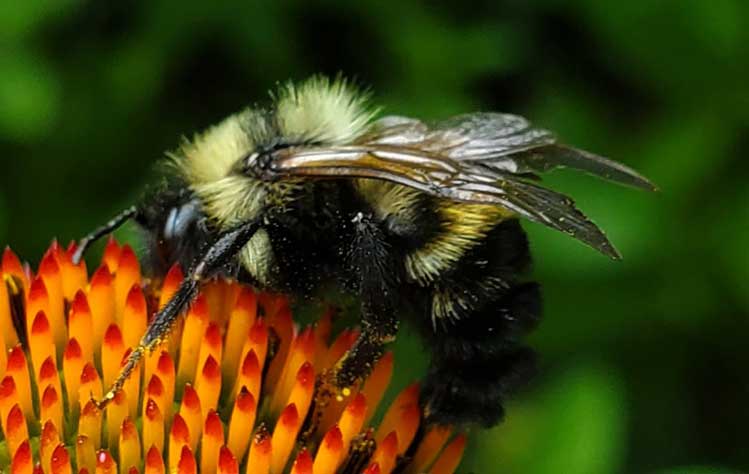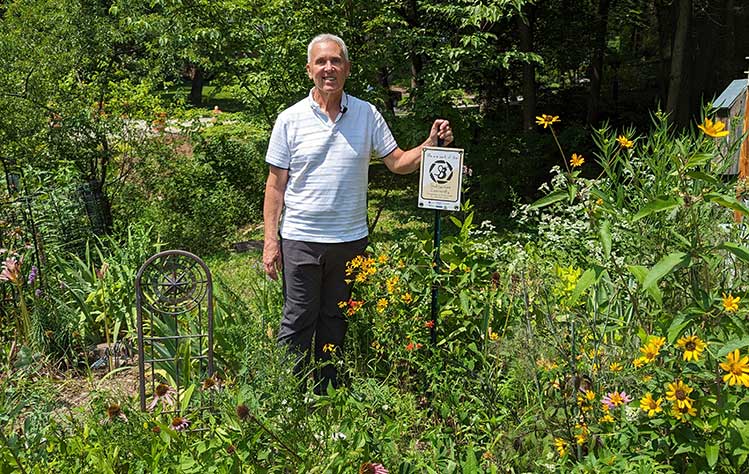Bee Not Seen in the St. Louis Region in More than a Century Photographed by Shutterbee Volunteer
August 01, 2023
 This photo of a Lemon Cuckoo bumble bee has scientists around the world buzzing as
to why it was photographed in a backyard garden in Belleville. Photo courtesy of Ned
Siegel.
This photo of a Lemon Cuckoo bumble bee has scientists around the world buzzing as
to why it was photographed in a backyard garden in Belleville. Photo courtesy of Ned
Siegel.
A volunteer for the Shutterbee Citizen Science Project, which is managed by Webster University Biology Professor Nicole Miller-Struttmann and partially funded by the University, captured a photograph of a bee that created buzz among biologists around the world.
Ned Siegel, who has volunteered for Shutterbee since its inception four years ago, captured a photo of a Bombus citrinus, also known as a Lemon Cuckoo bumble bee, in his home garden in Belleville, Illinois. This created a wave of excitement among biologists around the world because the Lemon Cuckoo is mostly found in the Northeast United States. Historical records indicate that the last time a Lemon Cuckoo was positively identified in the St. Louis Region may have been before the Civil War.
“I thought I had photographed one of the more common bumblebees I see in my garden, but when it triggered discussions from around the world, I was shocked,” Siegel said. “I looked up the Lemon Cuckoo and saw that I am too far from its traditional habitat, so I initially was skeptical. But now that scientists have positively identified it, I am in shock.”
 Citizen Scientist Ned Siegel stands in his garden next to the Shutterbee sign and
next to the flowers where he captured a photo of a Lemon Cuckoo bumble bee, a bee
that has not been seen in the St. Louis region since before the Civil War.
Citizen Scientist Ned Siegel stands in his garden next to the Shutterbee sign and
next to the flowers where he captured a photo of a Lemon Cuckoo bumble bee, a bee
that has not been seen in the St. Louis region since before the Civil War.
Siegel, a retired biochemist who has lived in his Belleville home for three decades, learned of Miller-Struttmann’s Shutterbee project through an email from the St. Louis Audubon Society, which he also belongs to. In Shutterbee, photographers choose a location and take a picture of every bee they can find during 30 minute surveys conducted every two weeks from May through September. Siegel, who has a large backyard garden, began surveying the bees in his garden for the project in 2020. He is among about 150 volunteers who participate in the project.
The photographs are uploaded to an app called iNaturalist, which is used by biologists and citizen scientists to catalogue plants, insects, and other wildlife. The photos are then reviewed by biologists to identify what is pictured. For Shutterbee, that data is used to help measure how many species of bees are found in an area and how they are interacting with plants.
Siegel uploaded his photos on July 15.
“iNaturalist initially suggested it was a Lemon Cuckoo, but I figured that it had to be wrong,” Siegel said. “Lemon Cuckoos aren’t found in Belleville.”
Within a few days, he saw comments appearing on his photos from biologists from around the world, including Asia. “There was a lot of buzz about my photo,” Siegel said with a grin, adding that one scientist looked up the species in the Smithsonian and discovered that the last positive identification of a Lemon Cuckoo in the St. Louis region may have been in 1854, seven years before the U.S. Civil War. Other records indicate that the last time Lemon Cuckoo may have been spotted in Southern Illinois was in 2007.
Miller-Struttmann isn’t surprised about the excitement, saying that finding it in the region has opened up a lot of speculation about why the bee was in Siegel’s garden. “The find suggests that gardens like the one Siegel grows — it uses many native plants — may be key to helping bee species survive despite environmental changes,” she said.
The Lemon Cuckoo is an unusual bumble bee because, unlike most other bumble bees, it doesn’t collect pollen or build its own hive, she said. Instead, the bee sneaks into the hives of other bumble bees and lays its eggs there, leaving its larva to be fed and raised by others. As a result, the Lemon Cuckoo is wholly dependent on other species of bees being healthy for its community to thrive.
“Cuckoo bees tend to be uncommon because of their life history. While they are more common in parts of the northeast, the species is also listed as threatened in several states within its core range, indicating that it is declining where it was once more common,” Miller-Struttmann said. “To find one on the periphery of where they are normally found tells us that the bee populations in Ned’s garden are relatively large, and also that the Lemon Cuckoo is holding on, despite changes to the climate.”
Miller-Struttmann is the Laurance L. Browning, Jr. Endowed Professor in Biological Sciences at Webster University's College of Arts and Sciences. She was hired in 2016 after teaching at State University of New York (SUNY). She holds a bachelor’s in Science from Loyola University and a PhD in Ecology, Evolution and Population Biology from Washington University St. Louis. She is the recipient of the 2019 Science Educator Award by the St. Louis Academy of Science.
Miller-Struttmann has previously made national news for her work into tracking bees through sound, the impact climate change has had on bees, research into bee declines and bee behavior during solar eclipses. Her work also has been featured in Smithsonian Magazine. In addition, she helped create the pollinator garden with the St. Louis Public Central Library and has worked with fifth and sixth graders and their science teachers in the area to teach the students the fundamentals of field research.
To learn more about science at Webster University, visit the College of Science and Health website.
